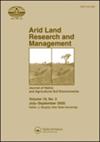半干旱草原灌木对土壤碳氮的影响主要由降水介导,对放牧不敏感
IF 1.6
4区 农林科学
Q3 ENVIRONMENTAL SCIENCES
引用次数: 2
摘要
全球旱地(干旱和半干旱)生态系统提供了一半以上的畜牧业生产,储存了大约三分之一的土壤有机碳(SOC)。生物地球化学库因灌木侵蚀、牲畜放牧和气候变化而发生变化。研究了植被微场、放牧和降水对土壤有机碳(SOC)和总氮(TN)的影响,并对不同海拔和年平均降水(MAP)梯度上的灌木入侵模式进行了描述。我们分析了家畜放养区未放牧区、靠近水源的高强度放牧区和远离水源的中等强度放牧区植被覆盖情况下的有机碳和全氮。放牧强度对土壤有机碳的影响不大(p = 0.12),而放牧强度对土壤有机碳的影响较小(p < 0.0001)。灌木增加了土壤有机碳(300-1279 g C m−2)和总氮(27-122 g N m−2),但在高MAP水平,灌木投入相对于草地投入的贡献或稳定性可能降低。多年生草本植物和凋落物盖度是土壤有机碳(r 2分别= 0.63和0.34)和全氮(r 2分别= 0.64和0.30)的显著预测因子。我们的研究结果表明,当草产量保持高时,旱地持续的灌木入侵可以增加有机碳储量,尽管这种响应可能随着MAP的增加而饱和。相比之下,放牧——至少在我们的地点的强度下——的影响较小。这些影响强调了了解未来气候和放牧如何相互作用影响旱地生物地球化学循环的必要性。本文章由计算机程序翻译,如有差异,请以英文原文为准。
Shrub influence on soil carbon and nitrogen in a semi-arid grassland is mediated by precipitation and largely insensitive to livestock grazing
Abstract Dryland (arid and semi-arid) ecosystems globally provide more than half of livestock production and store roughly one-third of soil organic carbon (SOC). Biogeochemical pools are changing due to shrub encroachment, livestock grazing, and climate change. We assessed how vegetation microsite, grazing, and precipitation interacted to affect SOC and total nitrogen (TN) at a site with long-term grazing manipulations and well-described patterns of shrub encroachment across elevation and mean annual precipitation (MAP) gradients. We analyzed SOC and TN in the context of vegetation cover at ungrazed locations within livestock exclosures, high-intensity grazing locations near water sources, and moderate-intensity grazing locations away from water. SOC was enhanced by MAP (p < 0.0001), but grazing intensity had little effect regardless of MAP (p = 0.12). Shrubs enhanced SOC (300–1279 g C m−2) and TN (27–122 g N m−2), except at high MAP where the contribution or stabilization of shrub inputs relative to grassland inputs was likely diminished. Cover of perennial herbaceous plants and litter were significant predictors of SOC (r 2 = 0.63 and 0.34, respectively) and TN (r 2 = 0.64 and 0.30, respectively). Our results suggest that continued shrub encroachment in drylands can increase SOC storage when grass production remains high, although this response may saturate with higher MAP. In contrast, grazing – at least at the intensities of our sites – has a lesser effect. These effects underscore the need to understand how future climate and grazing may interact to influence dryland biogeochemical cycling.
求助全文
通过发布文献求助,成功后即可免费获取论文全文。
去求助
来源期刊

Arid Land Research and Management
环境科学-环境科学
CiteScore
3.80
自引率
7.10%
发文量
23
审稿时长
9 months
期刊介绍:
Arid Land Research and Management, a cooperating journal of the International Union of Soil Sciences , is a common outlet and a valuable source of information for fundamental and applied research on soils affected by aridity. This journal covers land ecology, including flora and fauna, as well as soil chemistry, biology, physics, and other edaphic aspects. The journal emphasizes recovery of degraded lands and practical, appropriate uses of soils. Reports of biotechnological applications to land use and recovery are included. Full papers and short notes, as well as review articles and book and meeting reviews are published.
 求助内容:
求助内容: 应助结果提醒方式:
应助结果提醒方式:


